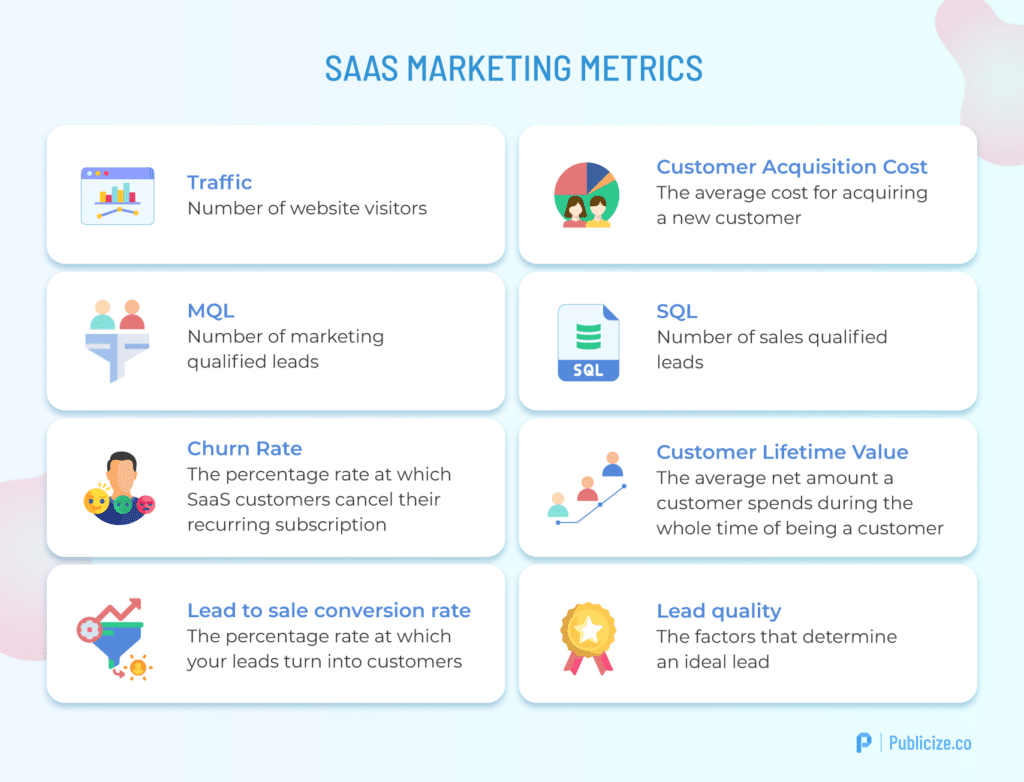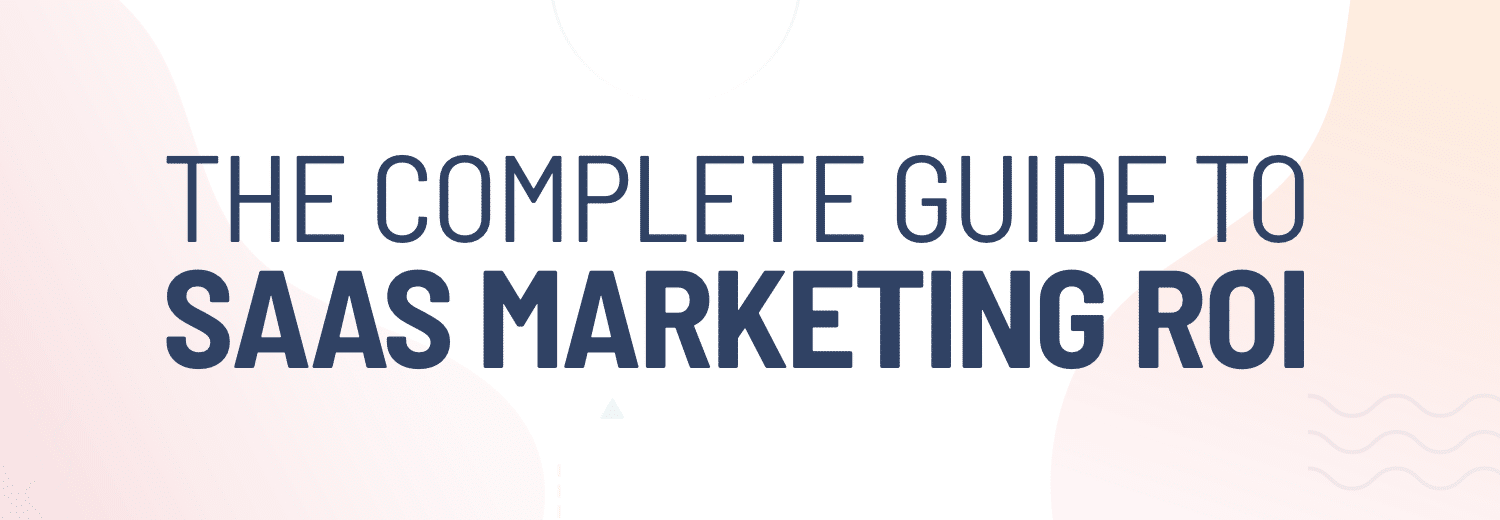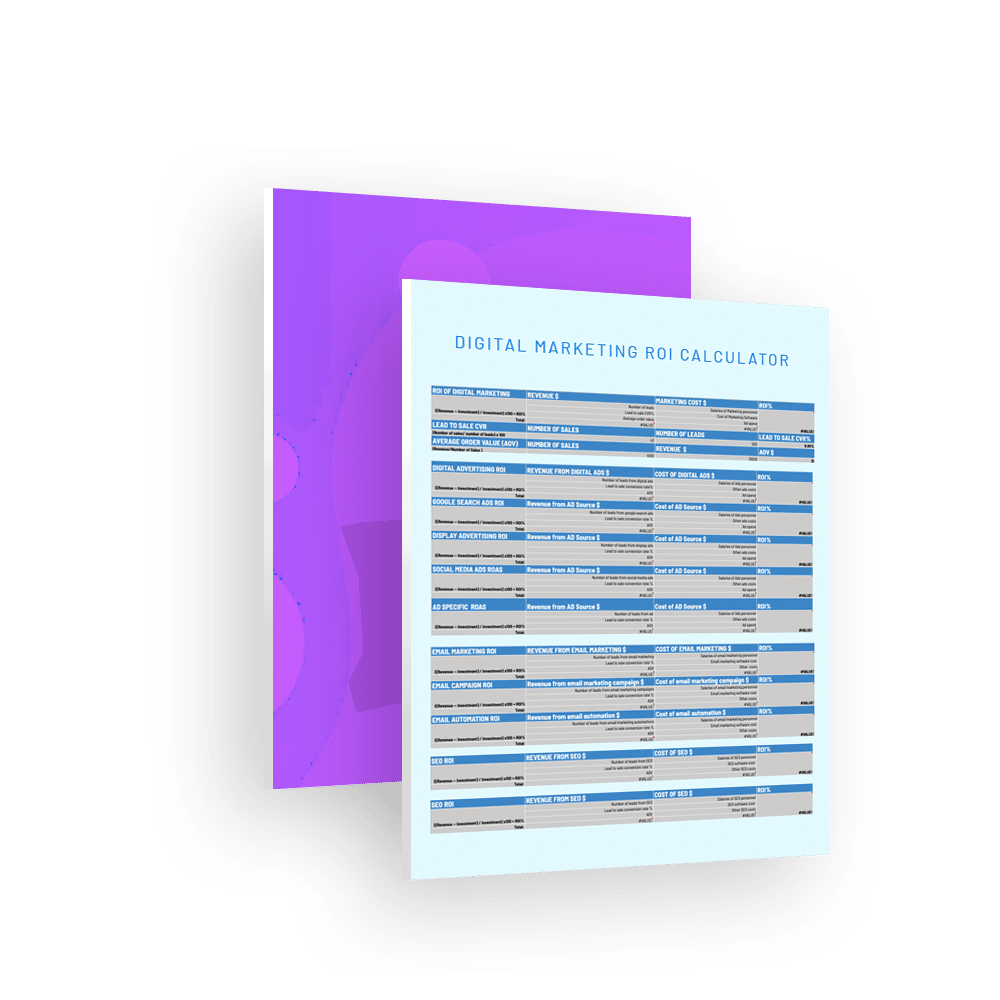Our digital marketing experts share their insights about ROI in digital marketing why it’s important when marketing for SaaS companies.
This guide will teach you how to measure SaaS marketing ROI, what metrics to focus on and how to improve your digital marketing ROI.
Let’s kick things off with a definition.
What is ROI in digital marketing and why it’s important for SaaS companies
ROI (Return of investment) in marketing is a profitability ratio that evaluates whether your marketing efforts are working or not. ROI can be calculated for overall marketing efforts, or for specific marketing channels and campaigns.
If you make more than a dollar for every dollar you spend on marketing, your ROI is positive.
So why is this important for SaaS companies?
In the saturated SaaS sector, it’s increasingly difficult to stand out from the competition and therefore more money is being poured into marketing.
In fact, on average, SaaS businesses spend 92% of their year-one revenue on client acquisition.
So to get ahead of the competitors in marketing for SaaS companies, it’s imperative that every dollar is spent in the right place.
This is where ROI comes in. It tells you what channels and campaigns are working well and what should be improved or removed. These insights will help you to spend your budget wisely, as well as identify potentially lucrative opportunities.
How to measure ROI on digital marketing
ROI of the traditional marketing means has always been a difficult task as TV and radio ad campaigns don’t produce much reliable data of the campaign success.
Digital marketing, however, is a different story.
The issue is rather that there is so much data that marketers don’t know what numbers to look at or what to do with the information.
A whopping 95% of data in organizations remains untouched and 39% marketers say they don’t know how to turn data into actionable insights.
So learning how to read data and turn it into actions can really help to take your SaaS marketing to the next level. Here’s an example on how to get started.
SaaS marketing ROI example
Let’s say you’re a SaaS startup with a goal to acquire new customers quickly and in a cost-effective manner. ROI can tell you whether your marketing efforts are supporting this objective.
The most common way to calculate the marketing ROI is to calculate the sales growth for the month, subtract the monthly marketing costs, and then divide by the monthly marketing cost.
ROI FORMULA: ((Revenue — Investment) / Investment) x100 = ROI%
To break this down, this is what you need to do:
- Determine the time period you’re measuring (month, quarter, year)
- Calculate all marketing costs within that period (salaries of the marketing personnel, price for marketing softwares, ad spend etc.)
- Calculate the revenue of all marketing efforts within that period (number of leads x lead to sale conversion rate (CVR)% x average order value)
So let’s do the math for our SaaS company example:
-Time period: January 2021
-Marketing costs: Marketing staff 5000USD, Marketing software 250USD, Ad spend 350USD = 5600USD
-Revenue: Number of leads: 400, Lead to sale conversion rate 20%. Average order value 200USD = 16 000 USD
Lead to conversion rate = (Number of sales/ number of leads) x 100
This means that your ROI from marketing is (16000-5600)/5600 x 100 = 185,7%
Or as a ratio, 16000/5600 = 2,85 profit for each dollar spent
PRO TIP: Even though ROI is generally monetary, it’s not always the case. If the objective for marketing for example is to increase brand awareness rather than sales, then dollar-value ROI might not be the best metric to measure success.
As you can see, ROI is a great indicator whether your overall marketing efforts are profitable, but it doesn’t really tell you what exactly is working and what isn’t.
Therefore, you need to calculate ROI from different marketing channels and dive deeper into specific metrics within them to get better insights.
Calculating SaaS marketing ROI by channel
According to the State of Marketing Measurement report, 82% of marketers say their executives desire every campaign measured, but only less than a third can effectively evaluate the ROI of each channel.
If you’re one of them – not to worry. It’s not as difficult as it sounds.
To keep things simple, let’s stick with the same SaaS ROI example. The company is using SEO and content marketing, email marketing and PPC search ads to reach new customers quickly yet with a minimal budget.
Now let’s break down each marketing channel individually to determine how they contribute to overall ROI.
PRO TIP: Email marketing delivers the highest average ROI with a return of $44 and Google Search ads come second with an average return of $8 for every $1 invested.
Email marketing ROI
To see how your email marketing is performing, you need to do the same calculation we used earlier, but this time just for this specific channel.
Firstly, make sure there’s a process for tracking. If you don’t know which channel your leads are coming from, it makes it impossible to know the source of your ROI. Notably, lead tracking can be set up using CRM software such as Salesforce or Hubspot.
Once you have the data, use the formula below.
Time period: January 2021
Marketing costs: Email marketing staff 1000$, Email marketing software 130$, =1130$
Revenue: Number of leads from email marketing: 100 x Lead to customer rate 20% x average order value 200$ = 4 000$
So the ROI for email marketing then would be ((4000 – 1130) : 1130) x 100 = 254% or as a ratio 4000/1130 = 3,5$ profit for each dollar spent
PRO TIP: Comparing ROI to previous months and years is vital in order for your SaaS marketing ROI to have real meaning. By doing a comparison with previous results, you’ll be able to see if you’re heading in the right direction.
Now do the same calculation for each channel that correlates with the same objective.
And to take the monotony out of this, here’s a handy resource for tracking SaaS ROI across all of your marketing channels.
Digging deeper into the data
Now that you’ve calculated ROI for each channel, you’ll be able to see which are your most profitable sources in terms of achieving your project goals.
Great start, but it doesn’t give you many actionable insights unless you dig deeper in the why. And how do we do that?
By taking a granular approach to data and learning how to read it.
You can get initial insights from comparing the ROI per channel to older results. Is ROI growing or decreasing? When was ROI at its highest and lowest? Was something done differently in those previous months?
To get more accurate insights, you need to break down each marketing channel to determine what campaigns and efforts were most successful by calculating their specific ROI and dive deeper into the specific metrics.
For example, say you’re trying to foster SaaS thought leadership by winning guest article features in SaaS-specialized publications. Getting the dofollow backlink is all well and good for your sites in terms of SEO, but what about the referral traffic? Are these users then converting into customers? Are you seeing an increase in your Domain Authority, and is this contributing to better rankings on your focus keywords?
Simply put, you need to know what you’re looking for and why. When it comes to marketing for SaaS companies, the issue is often having too much data rather than too little.
Important SaaS marketing metrics
Here are some important SaaS marketing metrics for you to dive deep into to understand better your campaign performance it’s relation to ROI.

-Traffic: Measuring the fluctuations in the amount of website visitors and tracking the traffic sources is vital in order to notice any significant changes.
-Marketing and Sales Qualified Leads: Tracking the number of marketing qualified and sales qualified leads per each channel helps you to see which channels or specific campaigns are most and least effective at generating new leads and opportunities.
-Customer Acquisition Cost (CAC): CAC can be calculated by dividing all the costs spent on marketing by the number of customers acquired in the period the money was spent. Calculating CAC for each channel is a good indicator which marketing channel is the most cost-effective in acquiring new customers.
-Churn: If your churn rate is high this should be a red flag for you to turn more efforts towards customer retention.
-CLV (Customer Lifetime Value): CLV is the metric that the whole SaaS industry relies on. It goes hand in hand with churn and CAC.
-Lead to sale CVR%: Lead to sale conversion rate is needed to calculate ROI and the formula is the following: (Number of sales/ number of leads) x 100. For example, if you have a high amount of leads but a low CVR, you need to investigate what obstacles are turning your customers away.
-Lead quality: Every company has to define what is a good lead for them and one way to do this is using a BANT rating. BANT determines whether a prospect is a good fit based on their budget, authority to make the purchase, need for the product, and timing. Tracking the quality is vital for noticing specific channels or campaigns that are bringing higher quality leads and leveraging these insights in future strategies.
PRO TIP: The benchmark for LTV: CAC ratio for SaaS companies is 3:1 or higher.
Data analysis – Turning the numbers to insights
The more specific information you’re able to get from your marketing campaigns, the more you’ll be able to use that data to grow your business and predict the future.
For example, if you notice that your PPC search ad campaign is bringing in a small amount of leads but with exceptional quality, you might be able to leverage this information on your other channels as well.
-What are the successful keywords you’re targeting?
-How is this audience behaving?
-What are the targeting settings you’re using?
This way, you might be able to transfer the successful PPC keywords to create SEO content or use the similar targeting settings on your social media campaigns to attract more of these delicious high quality leads.
The bottom line is, it’s useless to track the metrics unless you’re able to read them and turn them into actionable insights to increase your ROI.
How to improve ROI in SaaS marketing
Key to improving your SaaS marketing ROI is setting up a proper tracking system and measuring the right KPIs.
Keep your eyes on the prize and steer away from the vanity metrics that may sound impressive but don’t correlate with the revenue. Learn to read data and adopt a testing mindset for potential lucrative opportunities.
Always test different ways to find what’s working best for your audience. If you don’t know, you can’t grow.
Wrapping up
It’s all about the numbers, baby.
Data is everything in marketing for SaaS companies. Without it, you’re only able to make educated guesses. But with data, you can make informed decisions and future projections.
In order to effectively calculate ROI you need to measure all your marketing efforts consistently, track the right metrics and learn to turn these numbers into actionable insights to grow your SaaS business.











